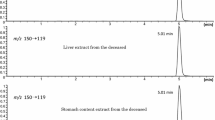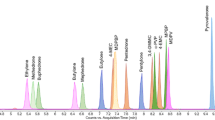Abstract
Post-mortem redistribution is known to influence blood and tissue levels of various drugs. An animal model was used in an attempt to elucidate this problem for the amphetamine analogue, 3,4-methylenedioxymethamphetamine (MDMA). Rabbits received 1 mg/kg MDMA intravenously (iv) and were killed 2 h later in order to simulate the state of complete distribution in the body. MDMA and 3,4-methylenedioxyamphetamine (MDA) concentrations were determined in blood, urine, bile, vitreous humour, and various tissues (eye globe walls, brain, cardiac muscle, lungs, liver, kidneys, iliopsoas muscle and adipose tissue) using a high pressure liquid chromatographic (HPLC) procedure with fluorescence detection. In the first group (control group, sampling immediately post mortem) considerable MDMA concentrations were found in the brain and both lungs. In addition, our data indicate the elimination of MDMA by hepatic biotransformation and excretion via the bile. When the animals were preserved either 24 or 72 h post mortem (second group), an increase of MDMA and MDA levels in the liver and the eye globe walls was noticed. In the lungs, on the other hand, they tended to decline as a function of increasing post-mortem interval. MDMA levels in cardiac and iliopsoas muscle were fairly comparable and remained stable up to 72 h after death. In the third group, ligation of the large vessels around the heart took place immediately post mortem, but significant differences in blood and tissue MDMA concentrations between rabbits of group 2 and 3 could not be demonstrated. We therefore conclude that post-mortem redistribution of MDMA at the cellular level (viz. by pure diffusion gradient from higher to lower concentrations) is more important than its redistribution via the vascular pathway. Finally, MDA levels were relatively low in all samples, thus indicating that this is not a major metabolite in the rabbit, at least within the first 2 h after administration.
Similar content being viewed by others
Author information
Authors and Affiliations
Additional information
Electronic Publication
Rights and permissions
About this article
Cite this article
De Letter, E.A., Clauwaert, K.M., Belpaire, F.M. et al. Post-mortem redistribution of 3,4-methylenedioxymethamphetamine (MDMA, "ecstasy") in the rabbit. Int J Legal Med 116, 216–224 (2002). https://doi.org/10.1007/s00414-002-0292-0
Received:
Accepted:
Published:
Issue Date:
DOI: https://doi.org/10.1007/s00414-002-0292-0




